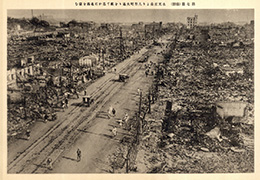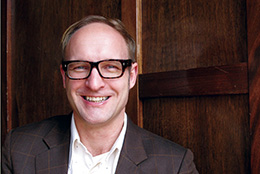 Ningyo-cho, a once bustling street in
Nihonbashi, Tokyo, days after the Great Kanto Earthquake of 1923.
Ningyo-cho, a once bustling street in
Nihonbashi, Tokyo, days after the Great Kanto Earthquake of 1923.
Overview: On 1 September 1923, Japan suffered one of the most destructive, deadly,
and dislocating natural disasters of the 20th century. The Great Kanto Earthquake and
subsequent fires destroyed 45% of Tokyo and 90% of Yokohama. Its human and
economic costs were likewise staggering: 120,000 killed,
1.5 million people rendered homeless, and monetary damage equating to nearly four times
Japan's national budget. As moral philosopher Shimamoto Ainosuke concluded, it was an
event that 'overturned Japan's culture from its very
foundation'. This project has resulted in the first study in English or
Japanese to explore how people interpreted and attempted to
use this catastrophe for larger political, ideological,
and economic ends. Moreover, it also documents and analyses
how citizens in Tokyo and across the nation responded to such
overtures for reconstruction and renewal between 1923
and 1930. One anonymous reader of my forthcoming book
from Columbia University Press described it as a study destined
to become 'the seminal book' on Japan's unprecedented 1923 catastrophe.
Significant Finding 1: The Earthquake as Heavenly Punishment. My research
uncovered that a broad cross section of political elites and
social commentators from divergent class and professional backgrounds described
Japan's 1923 calamity as an act of heavenly warning (tenkei
天警) and heavenly punishment (tenbatsu 天罰 or tenken
天譴). Why did they do so? I suggest to admonish society, particularly
Tokyoites, for becoming too consumer oriented, materialistic,
hedonistic, frivolous, luxury-minded and decadent. Many commentators saw 1920s
urban society as an anathema to the values upon which the modern, successful nation state of Japan had been built, such as
sacrifice, diligence, frugality, and sincerity. Published in
newspapers, academic and popular journals, in music, literature, and print, concerned
commentators employed divine-punishment arguments to legitimate calls for significant social
and ideological reforms in society. They hoped that the shock of the earthquake would wake
people from their path of spiritual decline and that the post-earthquake reforms would reorient
Japan on a proper trajectory.

Dr J. Charles Schencking
|
|
Significant Finding 2: Opportunity in the Ashes. Amidst the ruins, numerous elites
believed that a golden opportunity (kōki 好機) existed to construct a new Tokyo that
would not only reflect, but also reinforce new values and enable the state to better manage its
people on a daily basis. Drawing on progressive and high modernist social policy and urban
planning practices, bureaucrats devised intricate
plans for a new capital which they hoped would also illustrate their
country's burgeoning stature as a regional imperial power. New Tokyo would
not only be replete with infrastructure, but also be comprised of wide imperial avenues,
parks and open green spaces, and modern transportation networks that would make Tokyo
not only more liveable, rational, and beautiful,
but also more disaster resilient. My archival-based
study documented the intricate plans posited for a new imperial capital, and also analysed the
intellectual and ideological foundations upon which these plans were devised.
Significant Finding 3: Contestation over Reconstruction and Renewal. Was a new Tokyo
constructed and did the earthquake disaster prove to be the turning point that changed
the spiritual or moral trajectory of Japan? In a
word: no. Importantly, my project illustrated that
post-earthquake dreams for physical reconstruction became stuck in contentious
political, economic, and ideological debates that
defined the contours of Japan's interwar political
landscape. People from rural Japan and the politicians who represented them challenged
plans to spend large amounts of money on the reconstruction of one city. Other pro-democratic
elites suggested that radical reconstruction would disenfranchise property owners and
challenge Japan's constitutional and democratic precedents. Plans for moral regeneration proved
even more difficult to implement. Campaigns that aimed to restrict the consumption
of luxuries or ones that advocated sacrifice, thrift, and diligence rarely
secured the type of lasting results as proponents hoped. One commentator
who championed moral rejuvenation, Miyake Setsurei, lamented that the
'earthquake came too suddenly' and the earthquake mindset
'went very quickly' leaving the opportunist who desired fundamental change with only
a 'dream like impression'.
My findings—published in a forthcoming book
from Columbia University Press, delivered in two keynote addresses, three conference
presentations, and within a new first year course
entitled 'Catastrophes, Cultures, and the Angry
Earth'—illustrate how elites have attempted to use disasters for larger objectives and why
grand plans for reconstruction are limited by contestation and popular resistance. They will
undoubtedly prove useful today as Japan again attempts to recover from another
extraordinary catastrophe.
Dr J. Charles SCHENCKING
Department of History
The University of Hong Kong
schencking@hku.hk
|
